In June HIE claimed the funicular was perfectly safe
On 09/06/2023, after being contacted by several Parkswatch readers, I wrote a letter (see here) raising safety concerns about the Cairn Gorm funicular to Stuart Black, Chief Executive Officer of Highlands and Islands Enterprise (HIE), who own it.
On 21/06/2023, I received a reply not from Mr Black but from Customer Services, as follows:
“The design and implementation of the strengthening programme for the funicular viaduct was implemented and checked repeatedly by COWI and independent design checker Mott MacDonald – both of them world leading specialist bridge engineers.
Following completion of reinstatement works towards the end of 2022, a senior official from the authorised technical body for the Department for Transport conducted both a rigorous document review and physical inspection of the Cairngorm funicular viaduct and control system.
The inspector’s conclusions were positive and enabled the Department, through the UK Secretary of State for Transport, to authorise the safety cases, providing clearance and assurance for the funicular service to resume safe operations in January 2023.
This failed to address the issues I had raised.
In August HIE closed the funicular because it was unsafe
Just two months after making these claims, on 25/08/2023, HIE and CM(S)L took the decision to close the funicular ON THE GROUNDS OF PUBLIC SAFETY:
“At a board meeting today, Cairngorm Mountain (Scotland) Ltd (CMSL) agreed with the HIE decision to temporarily withdraw the funicular on the grounds of public safety.”
The only reasonable conclusion to draw from this is that the safety checks conducted before the funicular were re-opened were inadequate. Moreover, the funicular had already been closed every Tuesday from the end of May for further work, with no online ticketing on Wednesdays and Thursdays, and workmen were seen working in the evenings as well! That suggests that HIE were well aware of safety concerns when I wrote but rather than responding to my points their Chief Executive decided to deny anything was wrong.
HIE’s explanation for the closure
The news release issued by HIE (see here) claimed that:
“A 12-month snagging period and inspection programme has been ongoing since the funicular began carrying passengers again in January, following a two-year programme of works to strengthen the 1.7km viaduct that supports the track. Snagging and inspection are usual practice for major civil engineering projects.
This week, inspectors identified that some of the ‘scarf joint assemblies’ that link the beams at the top of the piers did not meet the required tension.”
This contained the usual disinformation. The programme of works may have been two years but the original plans were for them to be completed in one and the funicular was closed from August 2018 until 26th January 2023, i.e four and a half years. More importantly snagging and inspection are normal practice in ALL civil engineering projects and should have been completed BEFORE the funicular WAS re-opened, although obviously inspection programmes are an ongoing Health & Safety requirement! There are lots of definitions of snagging that illustrate this, for example (see here):
“Snagging does not have an agreed meaning, and is not a contractual term. It is a slang expression widely used in the construction industry to define the process of inspection necessary to compile a list of minor defects or omissions in building works for the contractor to rectify.
Generally snagging refers to a process that takes place a fortnight or so prior to practical completion when an area is considered complete by a contractor and is offered ready for inspection.
A snagging list (occasionally referred to as a punch list) is prepared and issued by the appropriate certifying authority, typically this will be the architect, contract administrator or employer’s agent. The faults that are identified should be rectified prior to a certificate of practical completion being issued.
Where the news release was correct was in stating that there were problems with the “scarf joint assemblies”and the pairs of stainless steel brackets which have been used to strengthen the connection between the in situ blocks and the concrete beams supporting the railway.
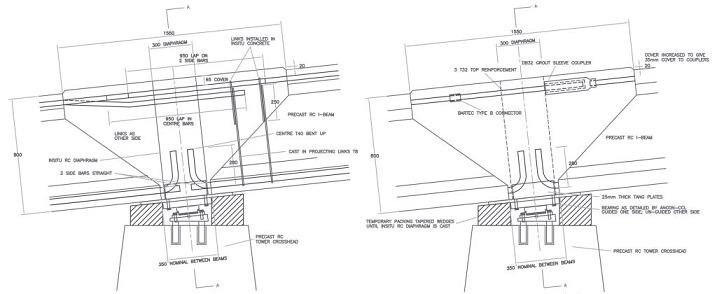
The cause of the problem and HIE’s solution
The concrete support beams are very heavy (see here) and were supported by a small metal plate at the base of the insitu block between them:
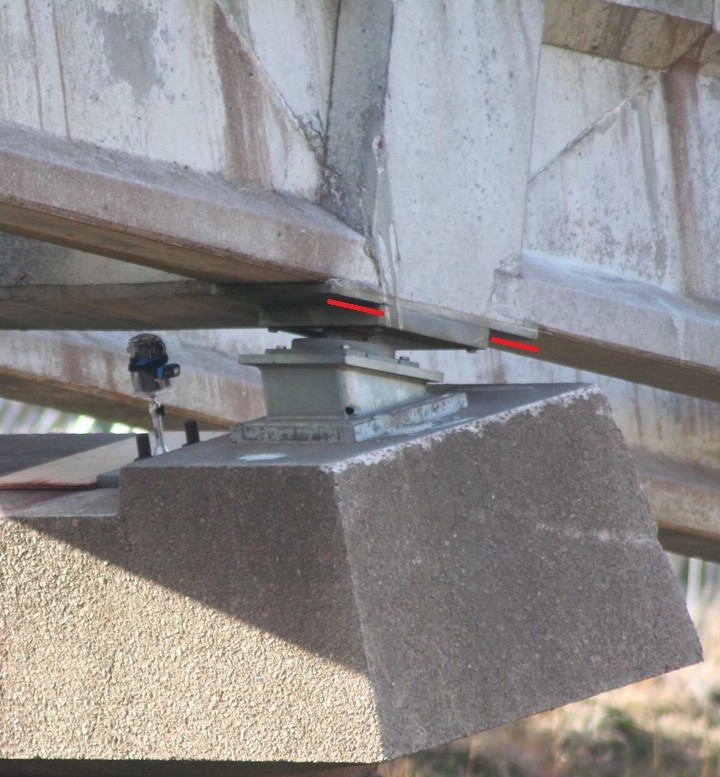
In a post I wrote two and a half years ago asking Will the repair of the Cairngorm Funicular Railway work (4)? I argued that, in order to support the ends of the “I” beams, the bearing plate should, at the very minimum, extend to the point vertically below the top of the scarf joint (i.e. where the beam reaches its full height) making each plate 1.55m long and probably at least 25mm deep. The problem was not the strength of the metal in the plates, it was the forces that were exerted on the thin ends of the concrete beams. As a consequence, these started to crack. HIE appears to have decided to address the issue not by inserting larger metal plates but by strapping pairs of brackets to the end of each beam to hold them together
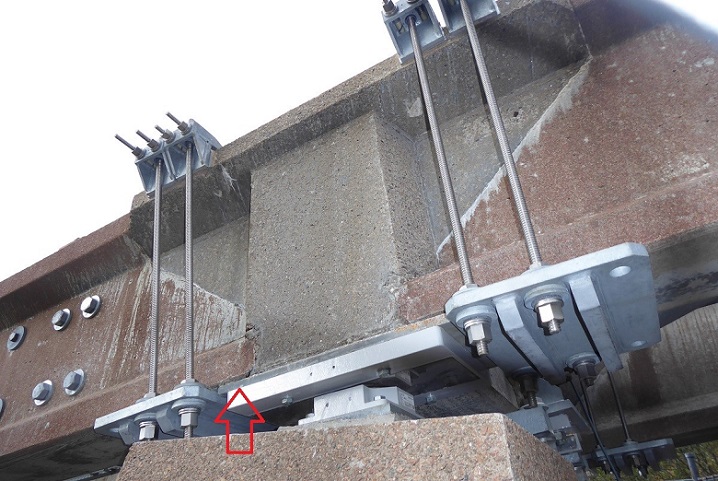
The red arrow shows how the original supporting plate has been retained although the bearing and support below it have been replaced.
HIE’s news release claimed that the closure follows:
“an inspection showing that some of the ‘scarf joint assemblies’ that link the beams at the top of the piers did not meet the required tension” but that “work to increase the tension of these assemblies is progressing well.”
What HIE did not say was that in at least one case the tension of the new support brackets appears to have been responsible for breaking up the concrete!
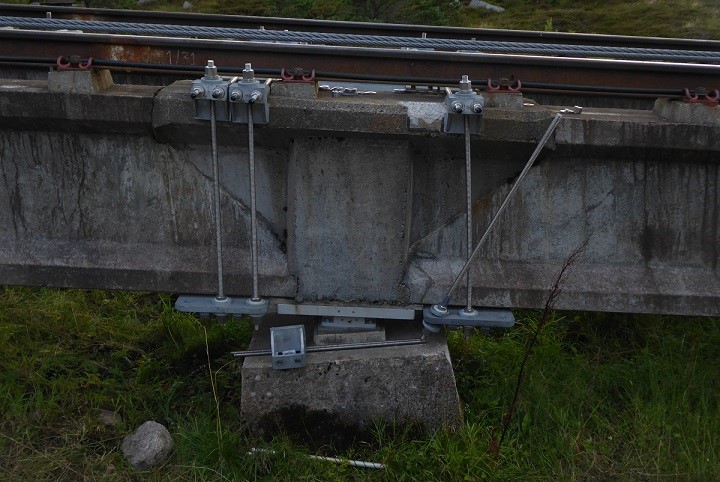
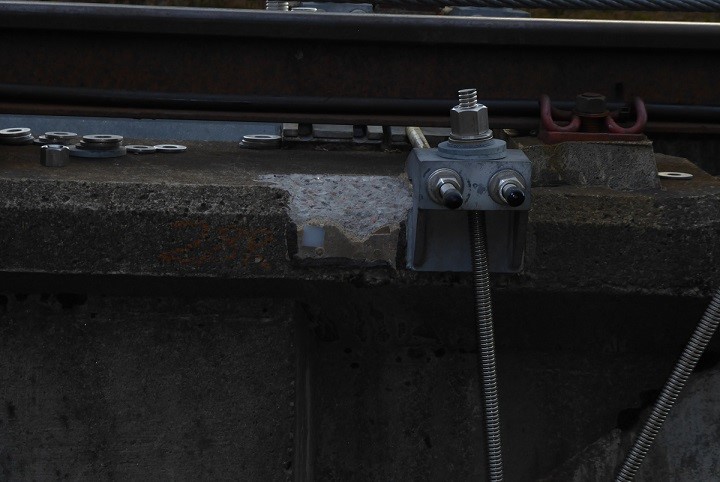
And that despite the fact that there is a layer of grout to cushion the pressure between the concrete and the bracket.
While it is clear the tension of the brackets was wrong, the reasons for this have not been explained by HIE. Generally stainless steel expands and contracts very little but if the brackets were put round the concrete in some of the very hot weather earlier this year, that might explain why the concrete shattered in the photo above. Other possible explanations is that brackets are not fit to do the job they were supposed to do or that the original people working on them were trained properly
In the medium terms it also appears quite likely that the brackets may move the stresses to another part of the concrete “I” beam. This reinforces my argument that the decision to build the funicular out of concrete rather than steel is at the root of the construction disaster.
When will the funicular be safe to re-open?
HIE’s news release went on to claim:
“Further inspection work has been completed and a series of trials using specialist equipment proved successful. Testing will be done continually as the tensioning work progresses.
A spokesperson for HIE said: “Every effort is being made to complete these works quickly so that the funicular can be brought back into safe use as early as possible.
“Our current expectation is that the job can be completed and the train back in service again before the end of September. The timescale will be kept under close review and we’ll take every opportunity to move at pace, while maintaining safety as the top priority.”
However, testing and adjusting all the brackets by the scarf joint assemblies is a time-consuming job which requires specialist teams. Initially ticket sales for the funicular were supposed to restart on 02/09/2023. This was then extended to 09/09/2023, then again to 16/09/2023 and again until 25/09/2023! We will see!
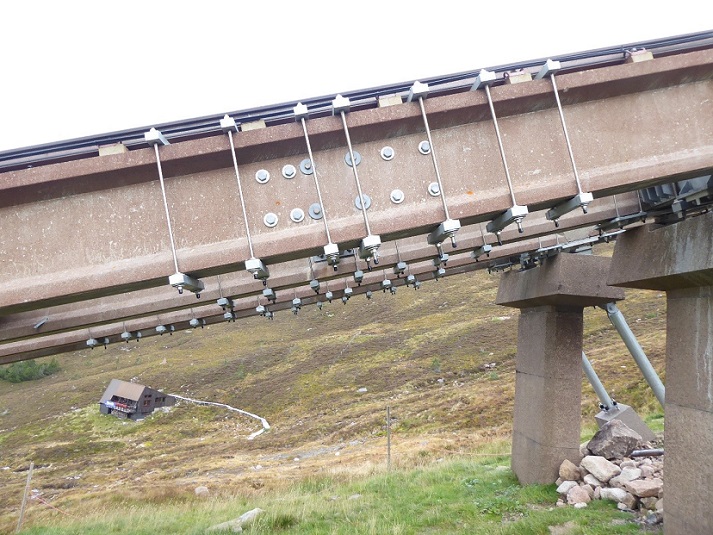
If the additional brackets that have been placed around some of the beams, as illustrated above, also need to be checked that raises questions whether the funicular will be repaired in time for the forthcoming winter season? The most that HIE will now commit too is the funicular COULD be back in service at the end of the month (see here).
Meantime the other safety issues I raised in my letter to Stuart Black, including the absence of an escape walkway should the funicular break down or have to stop in an emergency, remain unaddressed.
The cost of the funicular to the public purse
The unscheduled closure of the funicular means the funicular will lose yet more income adding to the projected £73m loss over 30 years as set out in the business case that Fergus Ewing approved. Judging by the state of the concrete, which I will consider further in my next post, it is likely that further repairs will be needed year after year.
Throughout Europe it has been found that there comes a point in the economic operational life of a Funicular, even when constructed out of steel, that the repairs and maintenance costs start to outweigh the financial benefits! Politicians should have appreciated that point actually occurred on Cairn Gorm in 2004 when the rent charged by HIE to the Cairngorm Mountain Trust (C.M.T.) and their subsidiary Cairngorm Mountain Ltd was reduced from £500k to just £100k!

It’s about time a full public inquiry was carried out into the whole sorry state of affairs. The snow sports, the wider community and the public, who are funding this farce, deserve better.
so, sheer utter disgrace and dangerous farce hardly covers it
Speaking as an engineer the more I learn about the detailed design of this structure the more shocked I am. I struggle to see how the scarf joint supports could have a life of over ten years. They will need constant monitoring and repair which puts more stress on these joints.
I consulted a mould maker for a price to make the necessary plywood mould for the “I” beams. His first comment when I told him what it was for and the span involved, “that’s going to break”!!! He has had some 36 years in the trade so I think his opinion could be considered as expert. A lecturer in rail technology also advised that because the beams were not prestressed that they should be 8cm deep for every 1m in length i.e.144cm for an 18m beam, not the 80cm as is used!
An absolute farce and environmental crime from the very outset
It seems apposite to highlight the very good analysis linked below. Lorna Slater’s ‘PFI for Trees’ is mentioned, as are ‘the trams’ and ‘the ferries’, but the funicular has been the blueprint for all these farces.
https://robinmcalpine.org/the-trams-scandal-is-scotlands-future-unless-we-act/
There seems to be a high level of incompetence in this project, maybe those in charge should consult with people who do these thing in the likes of Switzerland who build these things without any problems and to more challenging terrain
Funny thing that you should say that. The gentleman who was lead engineer for the Saas Fee funicular offered his services to HIE for the funicular build. They ignored him. He came up with an idea to stop the funicular tunnel from blocking. They ignored him. He then offered his sevices again for the repairs, this time as a world renowned expert in various forms of uplift, and they ignored him again. But then again he would have wanted to do a thorough and proper job! Last year an offer was made to take C.G. off HIE’s hands, again ignored. This week he is in Scotland close by playing golf. HMMMM I wonder!
Someone needs to bite the bullet and put this sorry farce out of it’s misery. There was a chance to do this several million pounds ago but it wasn’t taken.
Given the ongoing safety problems – we learned today that the earliest date for re-opening is now 16 October – and worrying number of tensioned strengthening brackets being added to support the scarf joints and other sections of the concrete beams supporting the funicular, I certainly wound not want to ride on the funicular. It increasingly looks like an accident waiting to happen!
Additionally there is the steady feeding of money into a facility that has been a ‘basket case’ for years. It seems that HIE’s and the Scottish Government’s only strategy is keep pumping in money and dig the mess they have made even deeper.
There will be a full public enquiry into this fiasco – it’s just a matter of time. Meantime, more and more taxpayers’ money goes down the drain.
I am a retired Chartered Civil Engineer with fifty years experience with major consultants and contractors. Having read all of your articles and the supporting information and having had initial discussion about building this project with HIE in the mid 90’s I am absolutely shocked as to it’s construction. All of these so called remedial works are quite frankly “lipstick on pig”. With temperature differences that the project experience day in and day out, summer and winter, using disparate construction materials in the original project and in these makeshift solutions with hugely differing thermal properties will always be an irreconcilable problem and may indeed be the initial cause.
“Sticking Plaster” repairs that can never last for the longterm – it all looks so amateur 🙁
Am I correct in saying that originally the funicular specification was for galvanised steel and not for reinforced concrete? If so then why was the design spec changed in favour of an inferior concrete structure?
Yes you are correct. I covered this in a post Concrete V Steel (1) on 31/07/2023 and two follow ups. HIE have claimed that Morrison Construction requested the change as part of a cost-cutting exercise, something that I disproved in the 2nd post of the series on 02/08/2023. Concrete would possibly have done the same job IF the beams had been pre-stressed, which they aren’t, or they should have been at least 144cm, possibly as much as 180cm deep, instead of the 80cm that were installed. The change from steel to concrete has now cost the taxpayer in excess of £25m for repairs and an unknown cost in the future.
It looks like there is no viable long term engineering solution to the interminable problems with the funicular railway. Basically it was designed to fail due to poor design and substandard materials.
Best to call it a day and put this scandal to rest with a public enquiry.
Surely Morrison Construction can be taken to task? In my head they are mean to be a very experienced construction company. If in the future I were in the market for a construction company I would not be allowing them to tender. They also make houses. Just saying.
The court case against the successors of those involved in the original construction has been settled and it looks like that is it
Have Cairngorm mountain made any statement about the railway since the comment on their website in October? That suggests that repairs are ongoing.
Is that true? Are they still working on it, or have they given up? Is it beyond repair without millions of extra pounds investment, or do they still intend to patch it up? If the latter, is there a timescale?